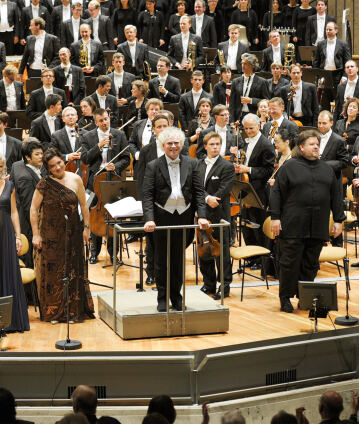Simon Rattle conducts Mahler’s “Symphony of a Thousand”

The choirs stretched into the audience galleries when Simon Rattle conducted a much applauded and cheered performance of Gustav Mahler’s Symphony of a Thousand. Even the premiere in 1910 attended by Siegfried Wagner, Richard Strauss, Arnold Schoenberg, Bruno Walter, Stefan Zweig and Thomas Mann was the most triumphant success in the life of Mahler. And the composer himself felt the symphony to be “the grandest thing I have done yet”.
Even in Gustav Mahler’s time, the Eighth Symphony was called the Symphony of a Thousand. The title may seem sensational, but not inappropriate. For no less than eight vocal soloists, two large mixed choirs, a boys’ choir, a large symphony orchestra, a separate brass ensemble and an organ are required for the performance.
But its monumental grandness is not only due to its instrumental and vocal forces, but equally because of its global textual basis. Starting with a medieval Pentecost hymn, and culminating in the closing scene of Goethe’s Faust, the symphony draws together fundamental philosophical ideas of Western history.
The premiere in 1910, performed before the cultural elite of the time, was the most triumphant success in the life of Gustav Mahler. And the composer himself felt the symphony to be “the grandest thing I have done yet”, as he wrote to the conductor Willem Mengelberg.
It was also Mengelberg who conducted the first performance with the Berliner Philharmoniker in May 1912. After another in 1928, it took almost half a century before the orchestra, under the direction of Seiji Ozawa, turned to the work again in 1975. Following another three performances, this is therefore only the fifth with the Berliner Philharmoniker since the Second World War – and the first with Sir Simon Rattle as conductor.
As an introduction to the symphony, the Rundfunkchor Berlin sings two original Latin motets, including the legendary, 40-voice Spem in alium by Thomas Tallis.
© 2011 Berlin Phil Media GmbH
Related interviews
Artists
Our recommendations
- Yannick Nézet-Séguin conducts works by Tchaikovsky and Ravel
- Christian Thielemann conducts Brahms’s “Deutsches Requiem”
- Kirill Petrenko conducts Tchaikovsky’s “Mazeppa”
- Claudio Abbado conducts “An Italian Night” at the Waldbühne
- Christian Thielemann conducts choral works by Johannes Brahms
- Marin Alsop conducts depictions of nature